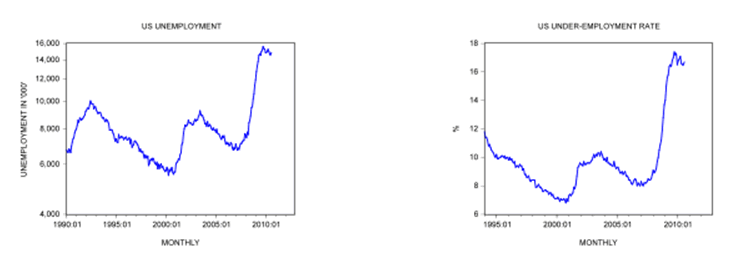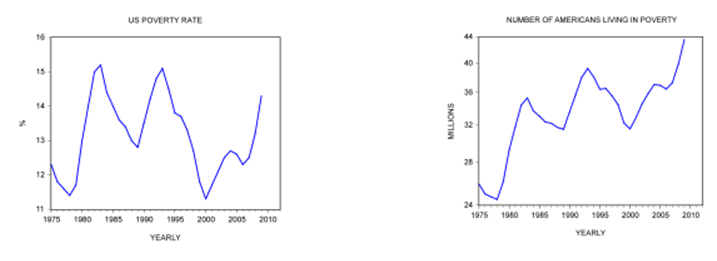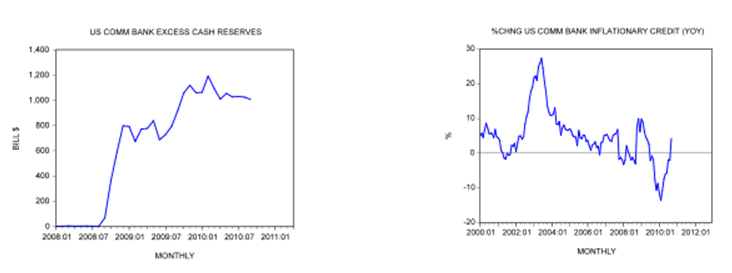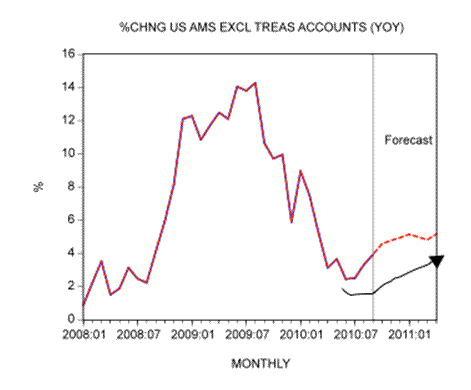Is a Reduction in Unemployment the Key to US Economic Recovery?
Economics / Economic Recovery Sep 21, 2010 - 05:49 PM GMTBy: Frank_Shostak
 Most experts are almost unanimous that the key to economic recovery is a reduction in the unemployment rate, which stood at 9.6% in August. The number of unemployed stood in August at almost 15 million. Also, the underemployment rate climbed to 16.7% in August from 16.5% in the month before.
Most experts are almost unanimous that the key to economic recovery is a reduction in the unemployment rate, which stood at 9.6% in August. The number of unemployed stood in August at almost 15 million. Also, the underemployment rate climbed to 16.7% in August from 16.5% in the month before.

But does it make sense that the key to economic growth is the lowering of unemployment? If this is the case then it is valid to conclude that changes in unemployment are an important causative factor of real economic growth.
This way of thinking is based on the view that a reduction in the number of unemployed means that more people can now afford to boost their expenditure, and as a result economic activity follows suit.
Now, the main driver of economic growth is an expanding pool of real savings. Fixing unemployment without addressing the issue of real savings is not going to lift the economy.
It is real savings that fund the enhancement and the expansion of the infrastructure. An enhanced and expanded infrastructure permits an expansion in the production of final goods and services required to maintain and promote individuals' life and well-being.
If unemployment were the key driving force of economic growth, then it would have made a lot of sense to eradicate unemployment as soon as possible by generating all sorts of employments. For instance, policy makers could follow the advice of Keynes and Paul Krugman and employ people in digging ditches or various other government-sponsored activities. Again the aim is just to employ as many people as possible.
A simple commonsense analysis however would have quickly established that such a policy would amount to a waste of scarce real savings. Remember that every activity, whether productive or nonproductive, must be funded. Hence, employing individuals in various useless activities would lead to a transfer of real savings from wealth-generating activities and thereby undermine the real-wealth-generating process.
Now the unemployment as such could be relatively easily fixed if the labor market were free of tampering by the government. In an unhampered labor market any individual that wants to work would be able to find a job at the going wage for his particular skills. Obviously, if an individual demands a salary unrelated to the market or is not prepared to move to other locations, there is no guarantee that he will find a job. For instance, if a market wage for John the baker is $80,000 per year, but he insists on a salary of $500,000, obviously he is likely to be unemployed.
Over time a free labor market makes sure that every individual earns in accordance to his contribution to the so called overall "real pie." Any deviation from the value of his true contribution sets in motion corrective competitive forces.
Ultimately, however, what matters for the well-being of most individuals is not that they are employed as such but that they have purchasing power in terms of goods and services. This is the key here. It is not going to be of much help to individuals if what they are earning will not allow them to support their lives and well-beings. Individuals' purchasing power is conditioned upon the infrastructure that they operate. The better the infrastructure is, the more output an individual can generate. A higher output means that a worker can now command higher wages in terms of purchasing power.
As we have seen, the key for an enhanced and expanded infrastructure is the increase in the pool of real saving. Consequently, any government or central-bank policy aimed at lowering unemployment by means of stimulus policies amounts to a policy of redistribution, which leads to economic impoverishment, that is, it undermines the living standards of most individuals.
According to government data, the percentage of Americans living in poverty rose to 14.3% in 2009 from 13.2% in 2008 — its highest level since 1994. A record 43.6 million Americans were living in poverty last year, the Census Bureau reported. Note that the increase in poverty came about in spite of massive fiscal and monetary stimulus measures supposedly meant to lift people's living standards.

Even former Fed chairman Alan Greenspan is getting uneasy with all the stimulus measures to which the American economy has been subjected. At the gathering on September 15 held at the Council on Foreign Relations in New York, he said,
We have to find a way to simmer down the extent of activism that is going on [in terms of stimulus spending] and allow the economy to heal.
Unfortunately Alan Greenspan is currently in the minority on this issue. As a result we have been constantly reminded that the Fed is carefully watching the unemployment market and other economic activity data.
This means that if the unemployment does not show any sign of a reasonable decline then the Fed is likely to push more money into the economy.
For the time being, we have been spared another onslaught by the Fed because US central-bank officials differ on the question of how weak the economic outlook should get before they start pushing a massive amount of money.
In the event Fed policy makers do agree to renew their stimulus program, a likely option is that they will resume a bond-purchasing program.
The point of buying bonds is to drive down long-term interest rates and encourage more lending by banks. This, it is held, will give a boost to economic growth.
The artificial lowering of interest rates cannot lift the supply of credit if the pool of real savings is in trouble. Remember that banks just fulfill the role of intermediaries — they can facilitate available real savings. However, they cannot create real savings — the key for economic growth.
Hence, bank activities as such cannot boost real economic growth.
It follows then that an artificial lowering of interest rates cannot generate more lending that is fully backed by real savings. The only credit that commercial banks can expand is credit out of thin air, that is, inflationary credit.
At present, we are observing that commercial banks are starting to make use of the massive amount of cash reserves pumped by the Fed during September 2008 to October 2009. (For instance the yearly rate of growth of the Fed's balance sheet jumped to 152% in December 2008 against 3.8% in January of that year.)
In early September the level of commercial-bank excess reserves stood at $1.007 trillion versus $1.026 trillion in August and $1.192 trillion in February.
As a result, the latest data show that the inflationary credit of commercial banks is starting to display a visible strengthening. The yearly rate of growth of this type of credit stood at 4.2% so far in September against −13.6% at the end of February.

It must be realized that an increase in inflationary credit amounts to an increase in money supply and hence to a diversion of real savings from wealth producers to non-wealth-generating activities — obviously then the expansion in credit on account of inflationary credit is bad news for economic growth.
After closing at 2.4% in June, the yearly rate of growth of our monetary measure AMS, which excludes Treasury special-financing accounts, climbed to 3.9% in early September.
On account of a likely further strengthening in the growth momentum of inflationary credit we forecast the yearly rate of growth of AMS to rise to 5.2% by April next year.

We suggest that if banks were to start utilizing the surplus cash reserves much faster than they are doing currently, this would likely prompt Fed officials to express concern.
Conclusions
Most commentators are of the view that the key for US economic recovery is drastically lowering the number of unemployed Americans. Once more people are employed, overall spending will rise, and general economic activity will consequently follow suit, so it is held.
We suggest that unemployment is not the key issue for economic growth. What matters for individuals is not whether they are employed as such but the purchasing power of their earnings. The key for this is the infrastructure individuals utilize in the production of goods and services. What permits an increase of the production of goods and services and hence raises peoples' living standards is an expansion and enhancement of infrastructure. What in turn permits this is an expanding pool of real savings.
Contrary to popular thinking, the Fed and government policies that are aiming at lowering unemployment don't improve people's living standards, but on the contrary they undermine the process of real-wealth generation and thus set in motion an economic impoverishment.
Frank Shostak is an adjunct scholar of the Mises Institute and a frequent contributor to Mises.org. He is chief economist of M.F. Global. Send him mail. See Frank Shostak's article archives. Comment on the blog.![]()
© 2010 Copyright Frank Shostak - All Rights Reserved Disclaimer: The above is a matter of opinion provided for general information purposes only and is not intended as investment advice. Information and analysis above are derived from sources and utilising methods believed to be reliable, but we cannot accept responsibility for any losses you may incur as a result of this analysis. Individuals should consult with their personal financial advisors.
© 2005-2022 http://www.MarketOracle.co.uk - The Market Oracle is a FREE Daily Financial Markets Analysis & Forecasting online publication.



